Official Site (Japanese) || Official Free Soundtrack
Just like its fully-capitalized name, there is nothing graceful nor elegant about GIGADEEP. Nearly everything part of this game is sloppy, loud, frantically kinetic, and, of course, ridiculously entertaining. There is a real sense of energy to this Mega Man X-inspired action platformer that I have rarely seen matched and, even with some glaring balance issues, I find myself going back to this game at least once every year.
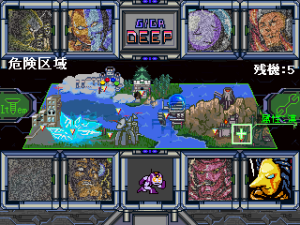 On a basic level, much of GIGADEEP is quite similar to Mega Man X with a bit of the original Mega Man thrown in. dashing, wall jumping, and a chargeable buster gun are all present and accounted for, to say nothing of the evil scientist in a skull fortress, the initial highway stage, and the eight bosses to choose between on a very familiar stage-select screen. Even the two main characters, Deep and Pappy, resemble and, to a degree, play like X and Zero respectively. There is no denying how similar the framework of GIGADEEP is to the average Mega Man game, but these similarities melt away once you start to delve a bit deeper.
On a basic level, much of GIGADEEP is quite similar to Mega Man X with a bit of the original Mega Man thrown in. dashing, wall jumping, and a chargeable buster gun are all present and accounted for, to say nothing of the evil scientist in a skull fortress, the initial highway stage, and the eight bosses to choose between on a very familiar stage-select screen. Even the two main characters, Deep and Pappy, resemble and, to a degree, play like X and Zero respectively. There is no denying how similar the framework of GIGADEEP is to the average Mega Man game, but these similarities melt away once you start to delve a bit deeper.
Let’s start by talking a bit about Deep and Pappy themselves. You can freely swap between them between stages and both characters have access to the gun, though Deep can charge slightly faster, and they gain the same abilities after defeating bosses. Where they differ is in their special abilities. Pappy, like Zero, has access to an energy sword, which can be used to either rapidly slash away at nearby enemies or to affect a larger area with a charged slash. Deep, who resembles Mega Man crossed with a rapidly-melting slime monster, passively recovers his health and, rather appropriately, has the ability to ‘bleed’ on enemies by tossing out two highly-damaging slime squares at the cost of some health. Between the two, Pappy tends to be better at getting through stages thanks to the versatility of his slashes while Deep is much better at annihilating most of the bosses due to just how much damage his special attack can cause.
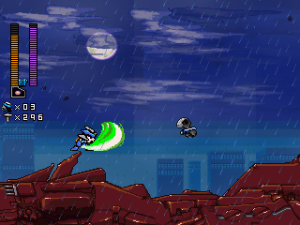
It is difficult to truly convey just how much energy this game has, but I’ll certainly try as this sense of energy is the most important part of the GIGADEEP experience. Everything in this game acts with a sense of urgency – you move ridiculously quickly even without dashing, crumbling platforms fall nearly instantaneously, and spawners will rapidly fill the screen with enemies if they are not immediately taken care of. When I’m playing this game, I frequently feel an overwhelming need to dash everywhere, to never stop moving even if it means taking a hit or two along the way. Part of this need to keep moving is simply due to the high speed of the game itself, but, to be perfectly honest, a much larger part of it is due to the simple fact that the stage design often demands it.
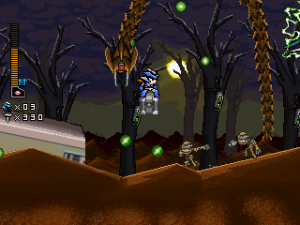 Stage design is where GIGADEEP is both at its absolute best and its worst. The stages themselves are wonderfully varied and range anywhere from a fairly traditional underwater stage to a city stage where you need to dodge around and ride upon music notes to a stage which starts with you riding on a rocket in order to infiltrate a pagoda filled to the brim with some decidedly less-than-stealthy ninjas. Death is common amongst these stages as many of them are filled to the brim with pits, spikes, and other forms of instant-death, but this is largely counterbalanced by some extremely generous checkpointing and the fact that you start every stage with a bare minimum of five lives. Spikes will kill you even if you have invincibility frames and the knockback effect after taking damage is much more severe than in most games, both in terms of its duration and in terms of how far you actually get knocked back, so Deep’s passive regeneration is not quite as useful as it might sound. Speed is the key here as there is also a near-constant sense of momentum to these stages; between enemy spawners, rising acid, strings of moving or falling platforms, lasers, rolling snowballs, and quite a few other things these stages do their best to encourage you to keep moving and frequently punish you for standing still.
Stage design is where GIGADEEP is both at its absolute best and its worst. The stages themselves are wonderfully varied and range anywhere from a fairly traditional underwater stage to a city stage where you need to dodge around and ride upon music notes to a stage which starts with you riding on a rocket in order to infiltrate a pagoda filled to the brim with some decidedly less-than-stealthy ninjas. Death is common amongst these stages as many of them are filled to the brim with pits, spikes, and other forms of instant-death, but this is largely counterbalanced by some extremely generous checkpointing and the fact that you start every stage with a bare minimum of five lives. Spikes will kill you even if you have invincibility frames and the knockback effect after taking damage is much more severe than in most games, both in terms of its duration and in terms of how far you actually get knocked back, so Deep’s passive regeneration is not quite as useful as it might sound. Speed is the key here as there is also a near-constant sense of momentum to these stages; between enemy spawners, rising acid, strings of moving or falling platforms, lasers, rolling snowballs, and quite a few other things these stages do their best to encourage you to keep moving and frequently punish you for standing still.
The stage design itself is fine the way it is and some instances of questionable enemy and hazard placement can be largely forgiven due to just how enjoyable and exciting the overall experience is, but the game is less-forgivably marred by several far-too-common glitches and oversights. In my most recent playthrough alone I encountered two checkpoints where you take damage from enemies while spawning in, at least one screen transition where it seems impossible to avoid taking damage when you enter the next screen, one instance of falling through the floor after making a screen transition, a handful of moving platforms with glitchy sprites where their tops got separated from their bottom segments, and once I even died near the start of a stage and ended up respawning in the boss room. Furthermore, the fortress at the end only consists of three stages, each with one or more boss fights, but there seems to be no way to continue from your current stage if you run out of lives, meaning you need to go through three of the hardest stages and some of the hardest boss fights in the entire game back-to-back on a single set of lives. Though I love the fast and loose feel of GIGADEEP’s gameplay, these issues belong to a definitely-unwelcome variety of sloppiness and can be frustrating, though not game-ruining, when encountered.
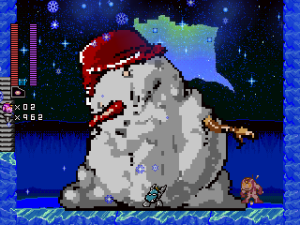 Going back to the positive side of things, let’s talk about variety because GIGADEEP is overflowing with it. Deep and Pappy may get the same set of weapons from defeated bosses, but, in a significant break from Mega Man tradition, there is no weapon energy to speak of. Boss weapons fall more into the category of ‘fun and interesting’ than that of ‘actually useful’, but the lack of an energy system means you are free to entirely replace your normal attack with your favorite weapon if you so desire and all eight of these weapons can even be charged for stronger or substantially different attacks. In addition to Deep and Pappy, you can unlock three other characters; I won’t go into too much detail on these secret characters, though they each have a very unique style of play and none of them are able to use the boss weapons. In addition to Energy Tank equivalents, there are several pages which can be found across the stages, each of which unlocks access to a handful of new items in the shop, which can be anything from a standard passive boost (any boost can be toggled) to a minigame. There are even ten difficulty settings, seven of which are above ‘Normal’, and these can increase the number of bullets enemies fire, speed up stage hazards, and even alter some boss attacks. Best of all, the game always autosaves between stages and there is no need to start an entirely new playthrough if you want to go through the game with a different character or change the difficulty setting.
Going back to the positive side of things, let’s talk about variety because GIGADEEP is overflowing with it. Deep and Pappy may get the same set of weapons from defeated bosses, but, in a significant break from Mega Man tradition, there is no weapon energy to speak of. Boss weapons fall more into the category of ‘fun and interesting’ than that of ‘actually useful’, but the lack of an energy system means you are free to entirely replace your normal attack with your favorite weapon if you so desire and all eight of these weapons can even be charged for stronger or substantially different attacks. In addition to Deep and Pappy, you can unlock three other characters; I won’t go into too much detail on these secret characters, though they each have a very unique style of play and none of them are able to use the boss weapons. In addition to Energy Tank equivalents, there are several pages which can be found across the stages, each of which unlocks access to a handful of new items in the shop, which can be anything from a standard passive boost (any boost can be toggled) to a minigame. There are even ten difficulty settings, seven of which are above ‘Normal’, and these can increase the number of bullets enemies fire, speed up stage hazards, and even alter some boss attacks. Best of all, the game always autosaves between stages and there is no need to start an entirely new playthrough if you want to go through the game with a different character or change the difficulty setting.
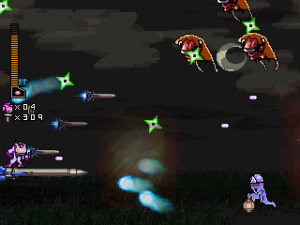 It would be impossible to end a GIGADEEP article without addressing the wonderful aesthetics, especially the sound and music. The spritework is commercial-quality and all of the characters are surprisingly expressive, especially Deep, who puts on a dumb grin whenever he attacks and starts to melt when he’s hit. It takes less than an hour with Mega Man X7 to understand just how horribly wrong voice acting in games can go, but here it works perfectly, in large part due to how outright silly and excited most of the characters sound. All of the playable characters utter some lines of dialogue occasionally, but Deep shouts at the top of his melting robot lungs in his odd and scratchy voice when he gets hit, when he picks up some items, and even when he attacks – it would be annoying if it wasn’t so ridiculously over the top. Enemies aren’t without a good bit of their own charm and include “Ninja!”-shouting ninjas, robotic bean pods, and a music boss who sometimes decides to take a smoke break in order to restore his health. Yet even beyond the art and sound design is the soundtrack itself, which I’m fairly certain is one of my favorite game soundtracks of all time. Almost every track is loud and fast to match the rest of the game, yet each is distinctive and memorable. There is a deliberately rough, percussion-heavy sound to many of the songs and underlying static or distortion effects frequently give them a unique feel without getting in the way of the overall melody.
It would be impossible to end a GIGADEEP article without addressing the wonderful aesthetics, especially the sound and music. The spritework is commercial-quality and all of the characters are surprisingly expressive, especially Deep, who puts on a dumb grin whenever he attacks and starts to melt when he’s hit. It takes less than an hour with Mega Man X7 to understand just how horribly wrong voice acting in games can go, but here it works perfectly, in large part due to how outright silly and excited most of the characters sound. All of the playable characters utter some lines of dialogue occasionally, but Deep shouts at the top of his melting robot lungs in his odd and scratchy voice when he gets hit, when he picks up some items, and even when he attacks – it would be annoying if it wasn’t so ridiculously over the top. Enemies aren’t without a good bit of their own charm and include “Ninja!”-shouting ninjas, robotic bean pods, and a music boss who sometimes decides to take a smoke break in order to restore his health. Yet even beyond the art and sound design is the soundtrack itself, which I’m fairly certain is one of my favorite game soundtracks of all time. Almost every track is loud and fast to match the rest of the game, yet each is distinctive and memorable. There is a deliberately rough, percussion-heavy sound to many of the songs and underlying static or distortion effects frequently give them a unique feel without getting in the way of the overall melody.
With its virtually unrivaled speed, its top-tier aesthetics, surprising amounts of customization, and oddly-unpolished style, GIGADEEP somehow managed to be a far cry from being a fine-tuned, refined masterpiece while still being one of the most unique and entertaining platformers out there.